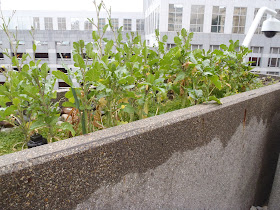For some reason, whether it's because I'm veg or because I'm a dietitian, people ask me quite often what I eat or what it is I'm eating. Most of the time I don't mind sharing ideas, but to be honest, a lot of the time I can't think of a good answer simply because I don't remember. I thought it might be a good idea to share some of my own unique recipes or alterations of common meals and snacks to equip me to better answer this question in the future.
As a side note, I am always astonished at what insults people will throw at you in regards to food. I can't tell you how many times someone will come up to me
while I'm eating and heckle me about my food, which is kind of insulting. Generally, it is not socially acceptable to go up to someone and say, "Your dress looks disgusting. I could never wear that dress. Ew." How is it any different with food? "Your meal looks gross. I could never eat your food. Ugh." I get this all the time. Has this ever happened to you?
However, don't let these impolite gestures dissuade you from trying my recipe ideas. Most people do know how to be courteous about food, and I've received far more compliments than "ews". Besides, I think most of the folks who generate comments like the above are closed-minded and addicted to the SAD (standard American diet) and haven't had much cultural or dietary adventure in their lives.
That said, I also thought it would be handy to show you the kitchen I'm working in. I have the tiniest kitchen I've ever seen. Maybe besides my college dorm which hardly counts as a kitchen (sink, counter, microwave); however, I did have more counter space in the dorm! My kitchen is about 10'x7'. This is the best view of the whole kitchen I could get, dirty dishes and all:

The amazing antique cast iron sink station and cabinets (see my kombucha mama on top of the fridge!):

Luckily, even though our kitchen is teeny tiny, we do have a 1911 apartment building with high ceilings. We build up! I nailed the scavenged drawers to the wooden wall as shelving for my dried herbs, spices, oils, nutritional yeast, bulk seeds & grains, my partner's whiskey collection, and other essentials:
 My partner built these beautiful shelves for my heavy duty cookware. Here you can also see our mini antique gas stove (more on it later!):
My partner built these beautiful shelves for my heavy duty cookware. Here you can also see our mini antique gas stove (more on it later!):

I have about one square foot of counter space which is a shelf with drawers on wheels. I have the essential knives, all free or thrift store/farmers market finds: bread, paring, chef's, cleaver:

Other essential equipment: my vintage glass Waring blender (thrift) and food processor (gift). My dad called me "the girl who doesn't go anywhere without her food processor" when I was petsitting one weekend and made sure to bring it along! You can also see my vermicompost bin. I made it out of another scavenged drawer and used shredded office paper from my work. It's great for small spaces and apartment composting as it doesn't take up a lot of space, requires little maintenance and doesn't smell. I've used the worm castings on my houseplants!

Arthur, my blind kitty, can't resist the boxes:

I also have a window shelf for cups, basil, lemongrass and cacti. I love that my tiny kitchen has two windows! The natural light is amazing! As you can see, I recently began purchasing reverse osmosis water from my local health food store mainly to use for my fermented tonic beverages like kombucha and water kefir. These SCOBYs (symbiotic community of bacteria and yeast) don't like chlorine or chloramine. However, since neither do your intestinal flora, it is good to eliminate these chemicals from your drinking and cooking and, if you can, your bathing water.

Since my kitchen is so small and I use it so many times a day, I have had to get creative with the space. I use the top of the refrigerator for a shelf and acquired a thrift store stepping stool to help me reach the highest places. The hardest part about this tiny kitchen, by far, has been the utter lack of counter space. I love the vintage cast iron sink unit and all of the character of the ancient mini gas stove.
So, now you know that all the recipe ideas to follow can be accomplished in any kitchen!





 Voila!
Voila!
 Pesto: a nutritious, versatile, raw, tasty, meal or snack.
Pesto: a nutritious, versatile, raw, tasty, meal or snack.













